


FAO offers technical support to affected countries for rehabilitation planning, project development and coordination among the many actors involved in the tsunami response.
The earthquake and subsequent tsunamis that swept across the Indian Ocean on 26 December 2004 will be remembered as one of the worst human tragedies in history. These natural disasters took more than 200 000 lives and shattered the livelihoods of some 5 million people in Southeast Asia and East Africa. Parts of Bangladesh, India, Indonesia, Kenya, Madagascar, Malaysia, Maldives, Myanmar, Seychelles, Somalia, Sri Lanka, Thailand, the United Republic of Tanzania and Yemen were affected.
The international community has responded with an unprecedented outpouring of public and private donations for disaster relief. The United Nations estimated that a total of US$6.3 billion has been pledged, committed or contributed, of which nearly US$1 billion was in response to the Flash Appeal launched by the United Nations on 6 January 2005. The Flash Appeal reflects the efforts of some 40 United Nations agencies and non-governmental organizations (NGOs) to plan and implement a strategic, efficient and coordinated emergency relief response for the initial six-month period. The sectors covered by the appeal include coordination, food, health, water and sanitation, shelter, education, economic recovery and infrastructure, agriculture, environment, and protection and human rights.
FAO has had a critical role in responding to this disaster, with the involvement of all relevant technical departments. The forest sector has much to contribute to rehabilitation and reconstruction of the affected areas, and the Ministerial Meeting on Forests, held on 14 March 2005, and the seventeenth session of the Committee on Forestry (COFO), held from 15 to 19 March, both included the Indian Ocean tsunami on their agenda. Both called on FAO to take a leadership role in guiding and facilitating the relief response, and to provide technical support and coordination of partners to ensure an integrated approach to rehabilitation.
Severe coastal flooding in Indonesia following the tsunami in December 2004 |
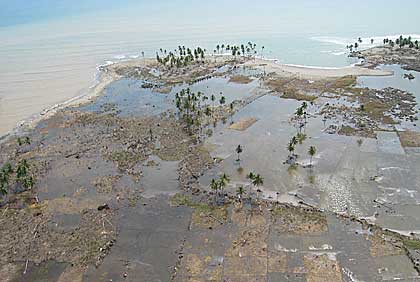 |
FAORAP/H. HIRAOKA |
Within a week of the disaster, FAO committed US$1.5 million of its own funds for needs assessments and recovery support in Indonesia, Maldives, Sri Lanka and Thailand. As part of the UN Flash Appeal, FAO called for an additional US$26.5 million to support recovery efforts in the most severely affected countries – Indonesia, Maldives, Myanmar, Seychelles, Somalia and Sri Lanka – and US$2.5 million for regional activities in partnership with the United Nations Development Programme (UNDP) and the United Nations Environment Programme (UNEP).
The majority of people affected by the disaster had agriculture- and fisheries-based livelihoods or were employed in associated enterprises. Using its own and donor-committed funds, FAO rapidly fielded expertise to assess the damage and losses to agriculture and fisheries and to assist governments in the planning and coordination of early recovery in these sectors. More recently, FAO has sent staff and consultants to provide similar assistance in the forest sector. In all, the Organization has deployed more than 70 international and regional experts in various areas of expertise to assist affected countries. It has recruited emergency coordinators for Indonesia, Maldives and Sri Lanka and a regional coordinator to provide the necessary coordination within FAO and with the key players. FAO is also providing direct assistance to farmers and fisherfolk in the form of boat repair kits and engine parts for fishing boats, fishing nets and other gear, seeds and farming tools, and repair of irrigation and drainage infrastructure, among other things. FAO’s role in delivering inputs is particularly important in the case of specialized equipment and in affected areas not adequately served by other organizations.
It has become apparent that FAO’s main comparative advantage and most essential role in rehabilitation efforts, as perceived by many affected countries, partners and donors, is in providing technical guidance, technical specifications and coordination in the areas of fisheries, agriculture and forestry and related cross-cutting programmes (nutrition, land tenure, etc.). Coordination among actors within countries is crucial, as the unprecedented level of donations and number of actors poses a serious risk of oversupply and inappropriate and fragmented assistance for recovery. FAO is also working to enhance cooperation, coordination and communication at the regional level. In early March, FAO’s Regional Office for Asia and the Pacific organized two workshops on regional coordination in the tsunami response in the fisheries and forest sectors. At the international level, FAO supports a coordinated approach through participation in the UN Flash Appeal. FAO has also held two briefings at headquarters for FAO Permanent Representatives of affected and donor countries.
FAO also has a role in information collection and dissemination. It maintains a Web site that provides continually updated information on FAO’s analysis of the evolving situation and response (www.fao.org/tsunami), which is linked to three more detailed technical sites on tsunami-related work in agriculture, fisheries and forestry.
FAO has also prepared a Tsunami Atlas, which includes satellite images, topographic and thematic maps and statistics (www.fao.org/tsunami/environment/maps.html). The FAO Tsunami Atlas is well advanced for Indonesia and Sri Lanka, and work is under way for the other affected countries.
In order to ensure that its tsunami response is internally well coordinated, FAO has set up two task forces, at the technical and management levels, involving all relevant departments of the Organization. These meet on a regular basis. Weekly conference calls are held between headquarters and FAO Representations in Indonesia, Maldives and Sri Lanka and with the Regional Office for Asia and the Pacific in Bangkok. In addition, an interdepartmental technical group has been formed to facilitate a coordinated approach to integrated coastal area management.
Immediately after the tsunami, the initial emergency response focused on food, health, shelter, water and sanitation (Banda Aceh, Indonesia) |
 |
FAORAP/H. HIRAOKA |
The role of the forest sector in recovery and rehabilitation is multifaceted. It includes increasing coastal protection through forest rehabilitation and afforestation; meeting the huge demand for wood products to reconstruct infrastructure and to replace destroyed wooden boats; contributing to local livelihoods and well-being through replanting of trees in home gardens, agroforestry systems and urban and peri-urban areas and by providing short-term employment; and protecting against pest outbreaks.
In the most-affected areas, there has been significant loss of both productive and ecological functions, including loss of habitat and diminished protection against future dangers from wind, waves and tidal surges.
Preliminary indications estimate that 56 000 ha of mixed agriculture and village land, 11 000 ha of forest and woodland, 9 000 ha of urban land and 4 400 ha of beach were severely damaged by the tsunami (ECJRC, 2005). More recent information sources, including UNEP’s rapid environmental assessment for seven countries (UNEP, 2005), indicate that, at least in the case of the forest resources, this estimate is likely to be low. Furthermore, mangroves could experience further die-off caused by the silting up of trees’ aerial roots and altered water circulation and drainage patterns. Additional studies and use of remote sensing imagery are needed for a more exact assessment of the damage to forest resources from the tsunami.
The affected forest and woody vegetation consists primarily of palm trees, broadleaf evergreen species and mangroves. In addition, community and urban tree plantings, home gardens and other agroforestry systems, fruit and amenity trees and shelterbelts were damaged by the tsunami.
These losses directly and indirectly impact local people. Forests and trees contribute directly to local livelihoods by providing wood and non-wood forest products, including construction timber, wood products and thatch, poles, fuelwood, food and medicines; and indirectly by providing shelter and shade. Additionally, mangroves provide spawning grounds and nutrients for fish and shellfish, and coastal forests provide a haven for a wide diversity of flora and fauna and play an important part in coastal protection. Trees and forests also have a significant role in affected countries that are highly dependent on tourism.
Reflecting widely held perceptions of the value of mangroves and other coastal vegetation, several governments have announced plans to rehabilitate large tracts of mangroves and to undertake reforestation efforts for coastal protection. Donor countries, NGOs and regional and international organizations have indicated their willingness to provide support. It is important that efforts be well coordinated among all actors and based on sound technical knowledge. Careful planning and implementation, with sound scientific input, suitable technologies and, above all, adequate local input are needed. Furthermore, it is essential that such efforts be undertaken within a larger framework of integrated coastal area management, and be well integrated with developments in fisheries, aquaculture, agriculture, tourism and road and infrastructure reconstruction. Planning of coastal green belts – in fact, any intervention in the affected areas – will need to take into account existing settlement patterns, land uses, livelihood needs and structures and environmental sustainability issues. Conflicts over competing interests for use of the land will have to be reconciled.
Many affected areas sustained massive damage to houses and other buildings, port facilities and civil infrastructure. Thousands of boats, including many of wood, were also destroyed. The reconstruction of infrastructure and repair or rebuilding of wooden boats will require large quantities of timber and other wood products. Providing for the localized demand for wood products, without triggering overexploitation of forest resources and in a way consistent with existing forestry and environmental policies and regulations, is a critical issue for some countries. For countries with limited forest resources, some or all of the need will have to be met through imported wood products. Salvaging wood in the affected areas offers potential to meet some of the construction needs.
Until their livelihoods are re-established, people in the affected areas need income and jobs. Establishment of forest nurseries and work in rehabilitating forests and tree planting are being considered in some places as opportunities for cash-for-work programmes. The restoration of home gardens and other agroforestry systems and planting of trees for various purposes is likely to be a significant component of medium-term rehabilitation efforts.
In the short term, there may be a heightened risk of forest pest outbreaks owing to the large quantities of woody debris. Salvaging wood and clearing the debris will help minimize this risk, yet if there are signs of an outbreak, action will be needed to bring it under control.
Visitors to the FAO atrium exhibit during COFO compare before-and-after images of Indonesian coastal aquaculture ponds washed away by the tsunami |
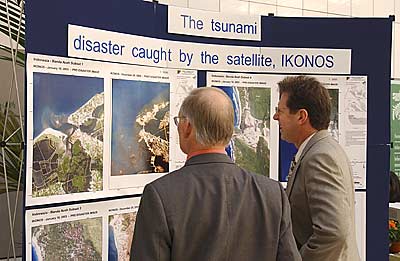 |
FAO/I. BALDERI |
Trees uprooted by the tsunami in Thailand: loss of coastal vegetation diminishes protection against future dangers from wind, waves and tidal surges |
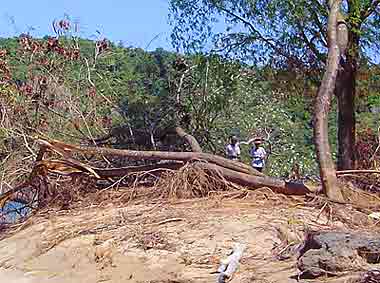 |
DEPARTMENT OF MARINE AND COASTAL RESOURCES, THAILAND |
In addition to massive damage to houses and other buildings, thousands of boats, including many of wood, were destroyed – their reconstruction will require large quantities of timber and other wood products |
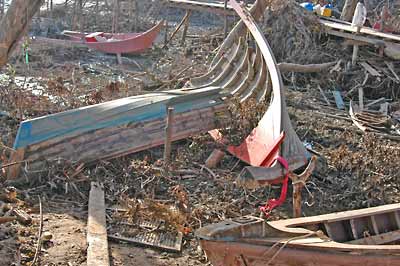 |
K. HASSANAI |
As appropriate to the immediate needs of the people affected by the tsunami, FAO’s response in the field has been predominantly in the fisheries and agriculture sectors, focused on helping to re-establish the livelihoods of fisherfolk and farmers quickly. Yet FAO has also developed a programme for providing forest-sector support to affected countries. Activities to date have included providing technical support in the field, encouraging cooperation and coordination among countries and organizations involved in the tsunami response, and collecting and disseminating relevant information.
In response to immediate needs for technical assistance in the forest sector, FAO recently fielded two consultants to Indonesia and a regional forestry officer to Sri Lanka, and supported the development of a project proposal in Seychelles. Requests for further assistance are expected to emerge as relief operations phase out and rehabilitation efforts commence.
FAO has begun to identify elements of its assistance programme for the rehabilitation phase, based in large part on information provided by the FAO Representations and field teams in the affected countries. This will be further refined as national plans for reconstruction emerge. A main objective of the mission currently under way in Sri Lanka is to develop the outline of FAO’s programme for rehabilitation assistance in the sector.
FAO is in contact with many regional and international organizations concerning tsunami needs assessments and response, with a view to encouraging collaborative activities and a coordinated, carefully planned response guided by sound technical expertise. In this regard, the FAO Regional Office for Asia and the Pacific convened a regional coordination workshop in Bangkok, Thailand on 7 and 8 March 2005, which brought together parties involved in post-tsunami forestry assessment and rehabilitation work (see Box).
The FAO Forestry Web site on the tsunami (see www.fao.org/forestry/tsunami) provides information on forest-related issues, country information on needs assessments and response, news releases and news clippings and links to useful technical information.
Coordinating a regional forest-sector response to the tsunami With myriad governments, non-governmental organizations (NGOs), UN agencies and other international organizations eager to provide support following the tsunami, coordination of efforts is critical. To facilitate collaboration in the forest sector, the FAO Regional Office for Asia and the Pacific organized the Regional Coordination Workshop on Rehabilitation of Tsunami-Affected Forest Ecosystems: Strategies and New Directions, in Bangkok, Thailand on 7 and 8 March 2005. About 40 representatives from affected countries, regional and international organizations, NGOs and donor countries sought a framework for collaborating towards a common objective: “a better future than existed before the tsunami, which is based on forests’ and trees’ contributions to poverty alleviation, food security, human capacity building, environmental sustainability and reduced vulnerability to natural disasters in the short and long term”. The workshop noted that there is a lack of clear, accurate and comprehensive information about the impact of the tsunami on coastal areas. The effectiveness of mangroves and other coastal vegetation in protecting coastal areas from major natural disasters needs to be assessed more thoroughly. Calculations of wood needs for reconstruction still have to be carried out. Limited technical knowledge and human resources are hindering rehabilitation efforts. Ambiguous land tenure and conflicting demands for use of affected lands are causing problems with coastal rehabilitation. Law enforcement needs to be strengthened for sustainable development of coastal areas. Intersectoral approaches to rehabilitation are needed to balance ecological, social, cultural and economic considerations. Rehabilitation efforts require careful planning with full stakeholder participation. The workshop defined eight guiding principles for rehabilitation efforts:
Participants recommended that a regional partnership be established to foster collaboration and coordination of forest-related rehabilitation. This partnership would include representatives from affected countries, international and regional organizations, NGOs, research organizations and donor countries, and would have four main functions:
The report of the meeting is available online: www.fao.org/forestry/tsunami |
Salvaging wood may offer potential to meet some of the needs for fuelwood and construction (Thailand) |
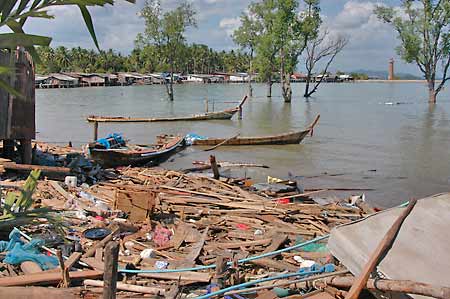 |
K. HASSANAI |
FAO, using its own funds and funds raised through the UN Flash Appeal, is actively supporting relief and rehabilitation efforts in the tsunami-affected countries. The initial response to the tsunami was to address immediate relief needs to re-establish livelihoods (particularly in fisheries and agriculture), provide technical support and coordination to affected countries, and collect and disseminate information. The forest sector will have an important role in rehabilitation.
As yet, information on the impact on forest resources and on other forest-related issues is limited and patchy. Detailed needs assessments related to forest issues in the affected countries are not yet available. It is important that such assessments be carried out as soon as appropriate and practicable so that forest-related interventions can be well integrated into national reconstruction plans and donor/technical assistance programmes. The assessments will require close coordination among countries, various UN agencies and others.
FAO has responded to requests for technical assistance in the field to address immediate needs in the forest sector. It is ready to provide further technical support to countries for rehabilitation planning and project development, and for coordination among the actors in the tsunami response. In addition, FAO is fulfilling an important information role through press releases, its tsunami Web sites, the FAO Tsunami Atlas, and other means – including discussions within the agenda of both the Ministerial Meeting on Forests and the seventeenth session of the Committee on Forestry (COFO) held in Rome in March 2005.
The Ministerial Meeting on Forests called upon FAO to take a leadership role as regards rehabilitation of tsunami-affected countries, and to collaborate closely with other UN agencies, members of the Collaborative Partnership on Forests (CPF) and other partners to provide technical support and coordination for forest-related activities in the area. At COFO, member countries recommended that FAO increase its forestry-related efforts regarding tsunami relief operations. COFO encouraged FAO to continue to coordinate efforts together with countries, international organizations, regional organizations and NGOs, and to promote an integrated approach to coastal area management and livelihoods in all sectors.
 Bibliography
Bibliography
European Commission Joint Research Centre (ECJRC). 2005. Mapping severe damage to Southeast Asia’s land cover following the tsunami. Available at tsunami.jrc.it/Reports/Tsunami_land_cover_change.pdf
United Nations Environment Programme (UNEP). 2005. After the tsunami: rapid environmental assessment. Available at: www.unep.org/tsunami/tsunami_rpt.asp